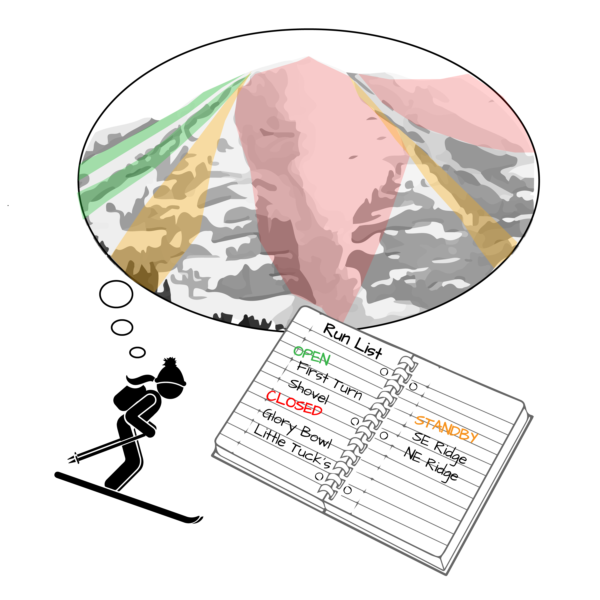Pre-established limits and openings on terrain based on forecasted avalanche conditions.
During their morning snow safety routine, some professional guiding and snow safety organizations define terrain openings and closures based on avalanche conditions. You can apply this concept to your backcountry tours to foster good communication between your partners, establish limits, manage human factors, and set goals for what additional information you might need to gather on your tour.
- Closed terrain / no-go terrain: Defining closed or “no-go” terrain before leaving the trailhead is a useful technique for managing heuristic traps. Closed terrain varies each day, depending on dynamic avalanche conditions. For example, if the avalanche forecast warns of dangerous persistent slabs on north and east aspects, your group would be prudent to close steep or connected terrain on those aspects for the day’s tour. By verbalizing or writing down closed terrain based on logical decisions made within the comfort of your morning routine, you are more likely to stick to those decisions in the face of human factors while on a tour. Snow safety and guiding operations apply the concept of terrain closures regularly.
- Standby terrain: During the morning routine of defining open and closed terrain, snow safety organizations might define “standby terrain”. This is terrain that you consider viable for traveling on, but only after you’ve gathered more information while on your route to address uncertainties. For example, based on recent observations of good stability and the day’s avalanche forecast warning of shallow storm instabilities, you might decide that riding a run called Baxter’s Glades is a reasonably safe option for today’s conditions. However, you recognize that last night’s storm totals could be higher than expected in that area, so you put the objective on standby until you can verify new snow amounts. When putting a run on standby, it is helpful to define what information needs to be gathered before opening it. A run on standby remains closed until your group objectively addresses the uncertainty by gathering the information defined that morning, and then agrees the run can be opened.
- Open terrain: Open terrain is the terrain where you have high confidence that you can ski and ride safely under the day’s avalanche conditions. This is your go-to terrain that everyone in your group feels comfortable with before leaving the house. If you are touring in open terrain, it is still important to evaluate your original assessments and look for evidence that contradicts open status. Unexpected snowpack assessments, changes in weather, or signs of instability can all lead to a change from open status to closed terrain.
